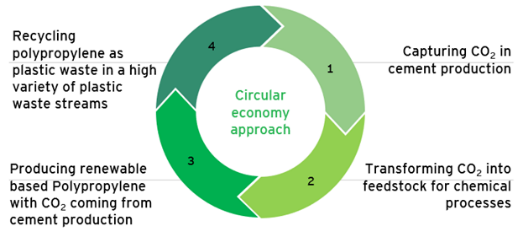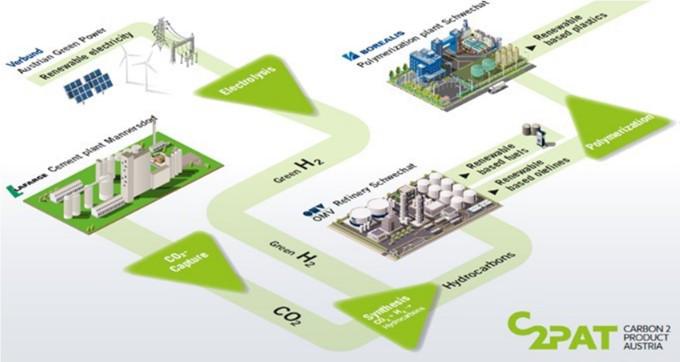Carbon2ProductAustria
Carbon2ProductAustria: eine Zusammenarbeit von Lafarge Zementwerke, Verbund, OMV und Borealis
Das Projekt "Carbon2ProductAustria" (C2PAT) in Zusammenarbeit von Lafarge Zementwerke, Verbund, OMV und Borealis zeigt einen CO2-neutralen Weg zur Herstellung von Kunststoffen auf.
Key elements of “Green Chemistry” are circularity and our ability to utilise waste streams like organic waste, used plastics, and CO2 as feedstock instead of virgin raw materials. C2PAT aims to demonstrate a novel, first-of-its-kind cross-sectoral carbon value chain at industrial scale. Industrial CO2 released during cement production is captured (10,000 tons/y for demo plant) and transformed with green hydrogen into feedstock for a variety of renewable based chemicals and value-add plastics products.
The overall system is based on the integration and joint operation of different technologies that will be combined into one novel holistic value chain. A facility cluster based in Austria comprising a carbon capture unit, a water electrolysis for the production of green hydrogen, a new synthesis route for methanol via Reverse Water-Gas Shift Reaction and methanol synthesis located at the site of Lafarge’s cement plant in Mannersdorf. A Methanol-to-Propylene unit will be integrated into OMV’s refinery and ultimately, value-add plastics will be produced at Borealis’ site in Schwechat.
By demonstrating the feasibility, C2PAT will elaborate innovative operational and business models to develop a scale-up concept for the carbon value chain. The key innovation is using CO2 emission from cement production as feedstock for petrochemicals - an integrated and cross-sectoral approach that has never been demonstrated before. C2PAT also demonstrates a circular economy approach in the cement and chemical sector given that renewable based plastics can be recycled and reused in various recycling streams. C2PAT will explore the market potential for renewable based products, develop models for control as well as for holistically optimizing the overall value chain.
New know-how will be gathered to transfer the demo plant to the next scaling step: A full-scale plant which is capable of converting more than 700,000 tons of CO2/y into renewable based products. Taking the next steps towards a climate neutral economy will require the right financial as well as favourable regulatory framework conditions. The success of C2PAT will largely depend on whether the right financial and regulatory framework conditions are created both at the EU and Austrian national level.
With this ambitious collaboration, Lafarge, OMV, VERBUND and Borealis are showcasing an innovative and viable solution for the transformation towards a carbon neutral economy in Europe.
The joint project is designed in 3 phases: In phase 1, based on a co-signed MoU the partners are currently evaluating and developing a joint strategy for project development and funding opportunities, business modelling and process engineering. Based on the results of phase 1, a cluster of industrial pilot plants in the Eastern part of Austria could be technically developed and realized until 2023/25 in phase 2. Phase 3 entails the full realization of the presented vision by scaling up to the full size of 700,000 tons of CO2 to be captured and used and will demonstrate the global scalability of the project.

Text von W. Haider, November 2020

